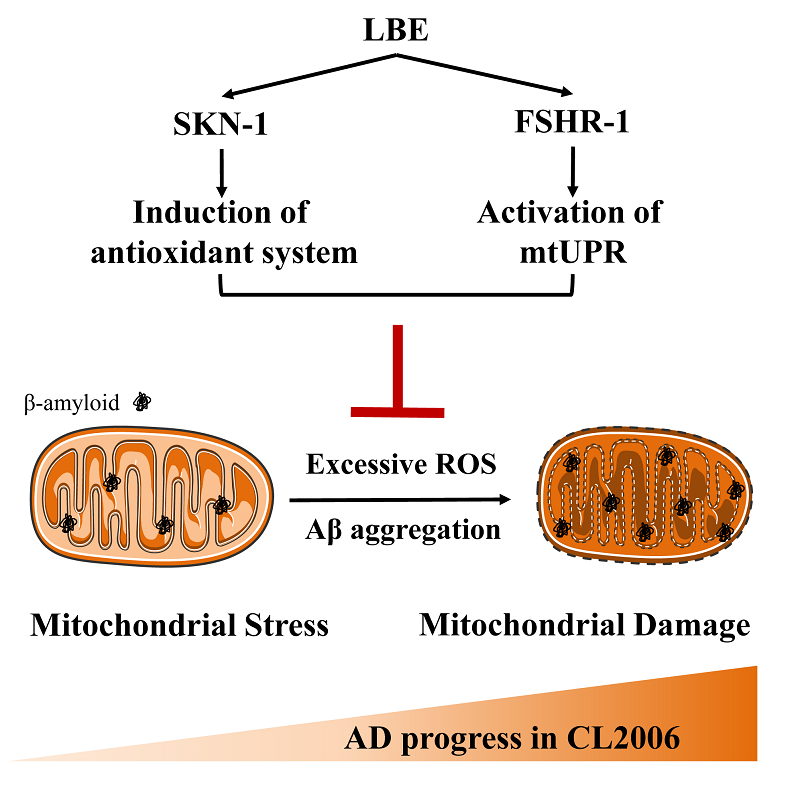CHEN Chang and her group reveal that a Lycium barbarum extract inhibits protein aggregation by inducing mitochondrial UPR
Lycium barbarum is a traditional Chinese herbal medicine, known as "longevity fruit". Alzheimer's disease (AD) is a common neurodegenerative disease in the elderly. The formation and aggregation of Aβ (β-amyloid) in the brain is considered to be the triggering mechanism of AD. Therefore, study on the production and clearance of toxic Aβ is an effective way to treat AD. CHEN Chang and her group, Institute of Biophysics, Chinese Academy of Sciences, found that L. barbarum extract (LBE) inhibited the development of Alzheimer's disease by activating the antioxidant system and mitochondrial unfolded protein response (mtUPR). The article entitled " A Lycium barbarum extract inhibits β-amyloid toxicity by activating the antioxidant system and mtUPR in a C. elegans model of Alzheimer's disease" was published online in the 《FASEB Journal》 on January 19, 2022.
The researchers used Aβ transgenic C. elegans CL2006 as a model to investigate the function and molecular mechanism of LBE in the production and clearance of toxic Aβ by adding LBE to E. coli OP50 at L4 stage. It was found that LBE significantly reduced the aggregation of Aβ and alleviated the muscle paralysis phenotype of CL2006 nematodes. On the one hand, LBE had strong antioxidant activity and could inhibit the production of excess ROS (Reactive oxygen species) by activating the SKN-1 pathway, thus inhibiting the generation and aggregation of Aβ. On the other hand, LBE activated mtUPR in CL2006 nematodes, and interference with the expression of key mtUPR genes reversed the LBE-mediated decline in Aβ level and the improvement of the muscle paralysis phenotype of C. elegans. However, interference with the expression of key genes in other proteolytic pathways, such as proteasome system, autophagy pathway, and ERUPR, did not inhibit LBE-induced Aβ reduction. In addition, interference with the expression of G protein-coupled receptor gene fshr-1 inhibited the activation of mtUPR by LBE. Thus, LBE inhibited Aβ aggregation and maintains protein homeostasis through FSHR-1-mediated activation of mtUPR, thereby preventing further mitochondrial damage.
This study for the first time found that LBE plays a protective role in AD model nematodes by activating mitochondrial UPR, providing a new mechanism for revealing the important role of L. barbarum in AD prevention and treatment. Unlike previous studies on UPR in AD, which mostly focused on ERUPR, this study provides new evidence for the cellular protective role of mtUPR in AD. Moreover, many diverse neurodegenerative diseases might have a common cause and pathological mechanism -- misfolding and aggregation of proteins. Therefore, this study also provides new reference for the prevention and treatment of neurodegenerative diseases by enhancing mtUPR.
Professor CHEN Chang, Institute of Biophysics, Chinese Academy of Sciences, is the corresponding author of this paper. Associate researcher MENG Jiao and PhD student LV Zhenyu are the Co-first authors. The work was supported by National Key R&D Program of China, Strategic Priority Research Program of the Chinese Academy of Sciences, Ningxia Key Research and Development Program Grant, Regional key projects of science and technology service network plan (STS plan) of Chinese Academy of Sciences, National Natural Science Foundation of China-Key program project.

Figure A mechanistic model of the protective effect of LBE in a transgenic C. elegans model of AD
Article link:https://faseb.onlinelibrary.wiley.com/doi/10.1096/fj.202101116RR
Contact: CHEN chang
Institute of Biophysics, Chinese Academy of Sciences
Beijing 100101, China
Email: changchen@ibp.ac.cn
(Reported by Dr. CHEN chang's group)

